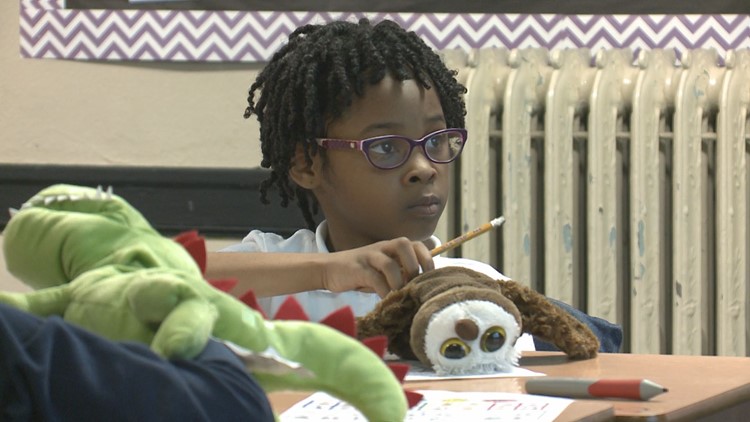ST. LOUIS — Whether you're a parent or not, you've no doubt heard, seen and experienced a child's tantrum, back talk and overall bad behavior. But what if there was a way to stop that behavior in its tracks? I was intrigued when I learned about a program inside two north St. Louis schools that’s teaching kids how to be more resilient and how to understand and control their emotions. The best part is, it’s actually working.
The second-grade class at Most Holy Trinity in North St. Louis is getting a lesson in being resilient.
Their lesson is being taught by Katie Muschinske. She’s the school’s licensed professional counselor with the program Mercy Kids. The program partnered with the St. Louis Archdiocese which has two counselors. Other than Muschinske, there’s also a licensed professional counselor at St. Louis Catholic Academy.
Speaking to the class Muschinske said, "If you're calm are you getting closer to the green zone? That’s right. What about if he gets really, really frustrated? He could be in the red zone."
She's helping the 6 and 7 year-olds to better understand and express their feelings.
She said, "When children are young, they have a hard time expressing themselves because they don't know the words to use."
One little girl explained what she learned to Today in St. Louis Anchor Allie Corey, "Like when you’re mad and you’re trying to calm down if you get a drink of water that will help you calm down more faster."
Often when a kid is upset or angry, they may react physically, cry or throw a temper tantrum. If that child understands why he or she feels that way they’re able to process what’s happening.
One boy said, "I was confused with my work and I thought about a calm place so I thought about what the teacher said and then I got right back to work."
Muschinske explained, "Instead of just being reactive all the time, we want to give them the tools for their self-regulation ahead of time."
Those tools include stuffed animals and a zone regulation chart. The chart helps guide students through their different emotions while teaching ways to bounce back to their calm zone.
The classrooms at Most Holy Trinity have what are called calm down spots. A place where a child can go to do whatever helps them return to the ‘green zone.’
2nd grade teacher Erin Scherer sees the positive impact.
She said, "Frequently throughout the day I’ll have my students say Mrs. Sherer can I go to the calm-down zone or Mrs. Scherer I just need a minute I need to take my 5 cool down breaths."
The best part? Anyone can do this, anywhere. Including at home.
Principal Jessica Kilmade says parents are critical in making it work.
"The most important thing we can do is partner with parents to say this is the common language that we need to be using to make sure your child is most successful. Things like zones of regulation and feeling words that we’re having in the classroom, parents are having that same conversation around the dinner table or in the car," said Kilmade.
It all comes down to constant communication.
"Parents need to help their students understand their feelings and that’s the key," said Muschinske.



